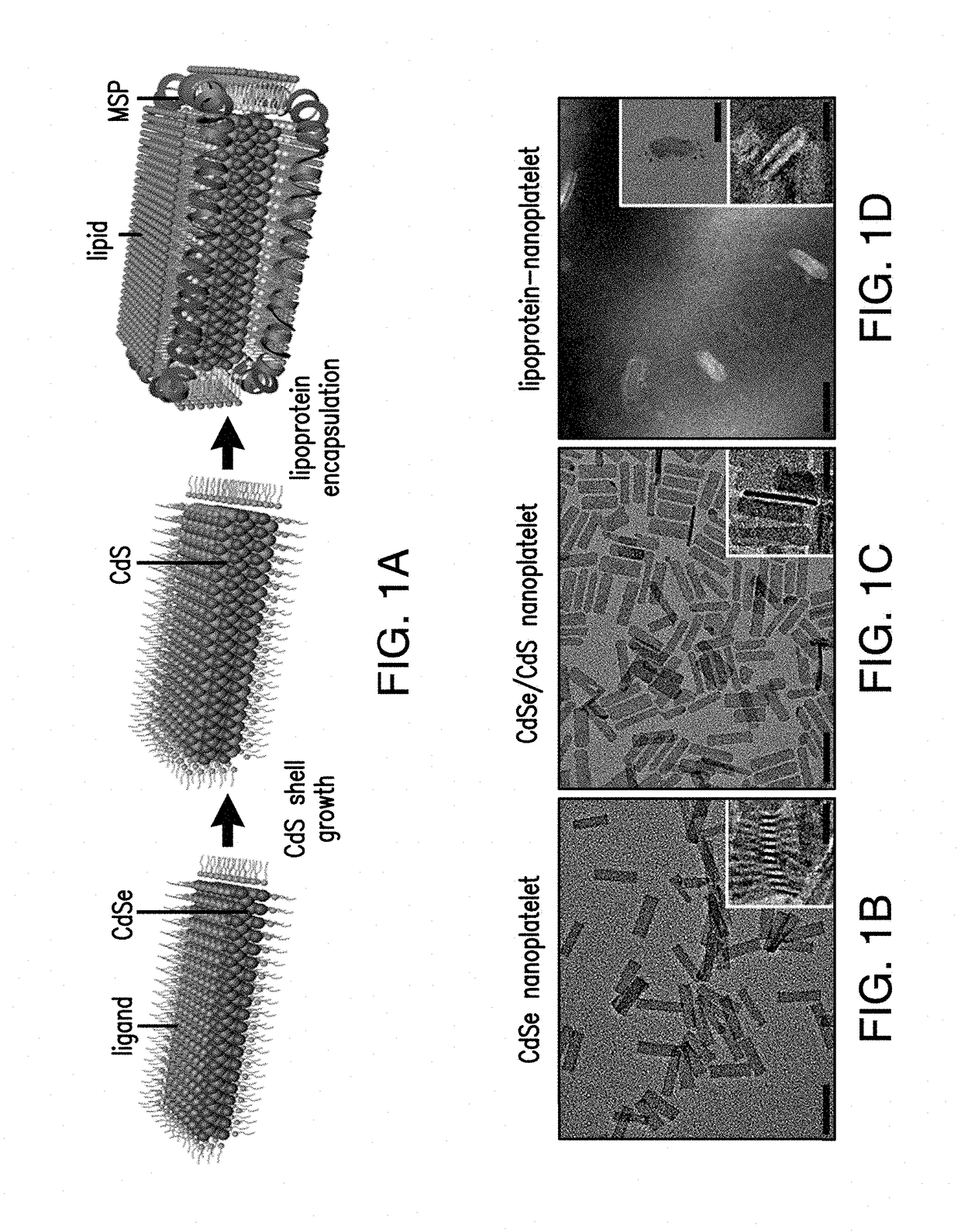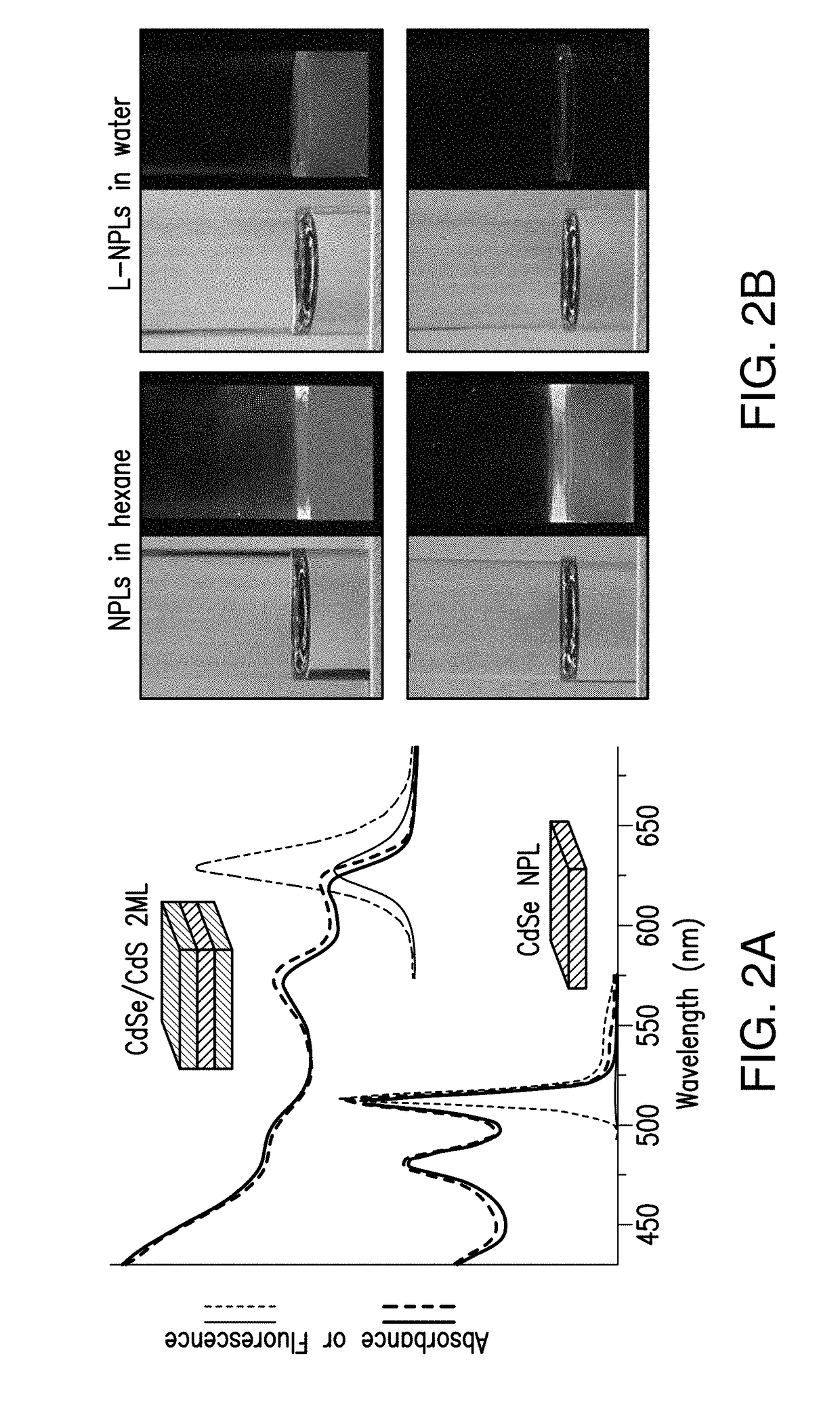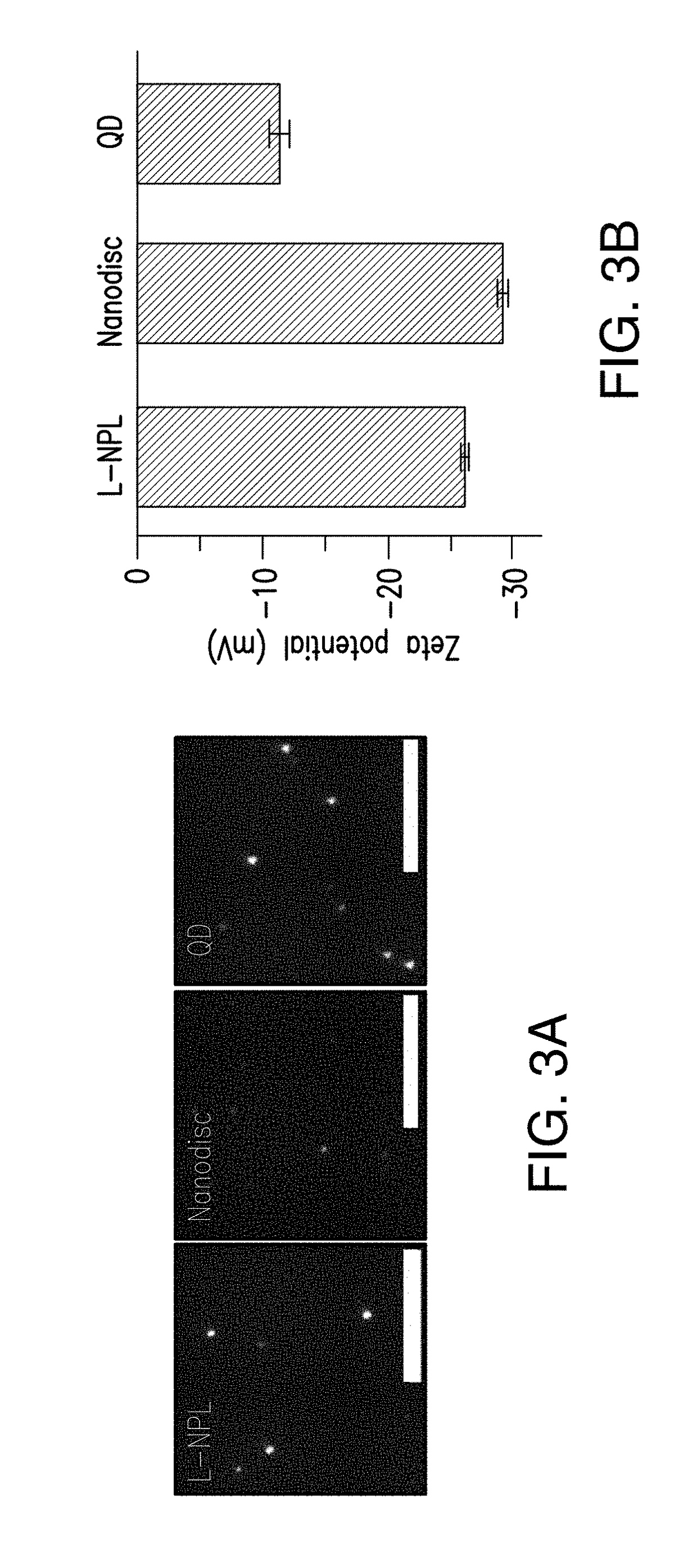Lipoprotein nanoplatelets: fluorescent, zwitterionic probes for molecular and cellular imaging
a technology of zwitterionic probes and lipoproteins, applied in the field of fluorescent, zwitterionic probes for molecular and cellular imaging of lipoprotein nanoplatelets, can solve the problem of challenging the colloidal stabilization of these nanocrystals in biological media
- Summary
- Abstract
- Description
- Claims
- Application Information
AI Technical Summary
Benefits of technology
Problems solved by technology
Method used
Image
Examples
example 1
[0077]Materials for Nanoplatelet Synthesis
[0078]Cadmium oxide (CdO, 99.99+%), cadmium acetate hydrate (Cd(Ac)2.H2O, 99.99+%), selenium powder (Se, ˜100 mesh, 99.99%), ammonium sulfide ((NH4)2S, 40-48 wt. % in H2O), tetramethylammonium hydroxide solution (TMAH, 25 wt. % in methanol), 3-mercaptopropionic acid (MPA, >99%), tributylphosphine (TBP, 97%), sodium chloride (NaCl), bromocresol green (ACS Reagent, dye content 95%), and dimethyl sulfoxide (DMSO, >99.9%, anhydrous) were purchased from Sigma-Aldrich. 1-octadecene (ODE, 90% tech.), oleic acid (OAc, 90% tech.), and oleylamine (OLA, 80-90% C18-content) were purchased from Acros Organics. Tris base (99%) and hydrochloric acid (37% in water) were purchased from Fisher Scientific. N-methylformamide (NMF, >99%) was obtained from Tokyo Chemical Industry. Other solvents including chloroform, hexane, methanol, ethanol, ethyl acetate, acetone, phosphate buffered sailine (PBS) were purchased from various suppliers including Acros Organics, ...
example 2
nic Polymer Synthesis
[0086]
[0087]Polymer 1
[0088]PAA (116.67 mg, 1.62 mmol COOH), HBTU (910.17 mg, 2.4 mmol), HOBt (356.98 mg, 2.31 mmol) were dissolved in DMF (5 mL). DIPEA (846 μL, 4.8 mmol) was added to activate the carboxylic acid and 10 minutes later S-trityl-protected cysteamine (181.8 mg, 0.57 mmol) and DMDA (120 μL, 1.1 mmol) were added. The mixture was stirred overnight at room temperature. The product was precipitated with the addition of 10 mM NaOH solution (250 mL) and collected by centrifugation. The product was redissolved in acetone, mixed with anhydrous Na2SO4, filtered, and dried under vacuum. The viscous oil was washed with ether to remove any residual solvent to yield the product 1 as a yellow powder. Yield: 40%. 1H NMR (d6-DMSO, δ, ppm, 500 MHz): 7.1-7.4 (Ar—H, br), 3.25-3.6 (br), 2.84 (—S—CH2, br), 2.75 and 2.4 (—CH2—N3, br).
[0089]Polymer 2
[0090]1 (100 mg, 0.7 mmol) was treated with 1,3-propanesultone (129 mg, 1.05 mmol) in dry propylene carbonate (1.5 mL) under ...
example 3
let (NPL) Synthesis
[0093]Core CdSe NPL
[0094]CdSe NPLs were synthesized and purified using literature methods with slight modifications.23 In a typical synthesis, CdO (0.6 mmol), OAc (1.2 mmol), and ODE (15 mL) were mixed in a 50-mL round bottom flask (r.b.f.) and heated to ˜200° C. under nitrogen until the mixture became clear and colorless due to the formation of cadmium oleate. The solution was cooled to 140° C. and Se powder (0.6 mmol) was added. Then the temperature was quickly raised to 240° C. at a rate of ˜20° C. / min. At 190° C., Cd(Ac)2 (0.6 mmol) was swiftly added into the mixture to initiate NPL growth. After reaching 240° C., the mixture was heated for an additional 10 min and the reaction was quenched by removing the heating mantle. When cooled to ˜130° C., OAc (1 mL) was added to stabilize the NPL dispersion. The reaction yielded a mixture of NPLs with the first exciton λabs at 510 nm as well as quantum dots (QDs). For purification, the reaction mixture was diluted with...
PUM
| Property | Measurement | Unit |
|---|---|---|
| molar ratio | aaaaa | aaaaa |
| width | aaaaa | aaaaa |
| width | aaaaa | aaaaa |
Abstract
Description
Claims
Application Information
 Login to View More
Login to View More - R&D
- Intellectual Property
- Life Sciences
- Materials
- Tech Scout
- Unparalleled Data Quality
- Higher Quality Content
- 60% Fewer Hallucinations
Browse by: Latest US Patents, China's latest patents, Technical Efficacy Thesaurus, Application Domain, Technology Topic, Popular Technical Reports.
© 2025 PatSnap. All rights reserved.Legal|Privacy policy|Modern Slavery Act Transparency Statement|Sitemap|About US| Contact US: help@patsnap.com



